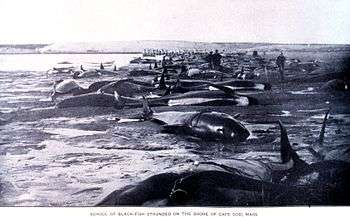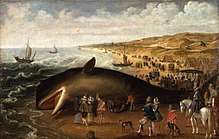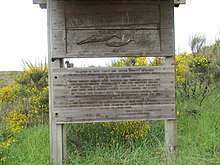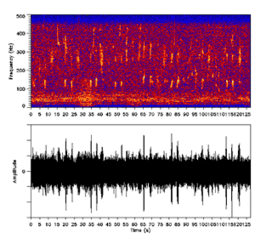Cetacean stranding
Cetacean stranding, commonly known as beaching, is a phenomenon in which whales and dolphins strand themselves on land, usually on a beach. Beached whales often die due to dehydration, collapsing under their own weight, or drowning when high tide covers the blowhole.[1] Cetacean stranding has occurred since before recorded history.[2]

Several explanations for why cetaceans strand themselves have been proposed, including changes in water temperatures,[3] peculiarities of whales' echolocation in certain surroundings,[4] and geomagnetic disturbances,[5] but none have so far been universally accepted as a definitive reason for the behavior. However, a link between the mass beaching of beaked whales and use of mid-frequency active sonar has been found.[6]
Species
Every year, up to 2,000 animals beach themselves.[7] Although the majority of strandings result in death, they pose no threat to any species as a whole. Only about ten cetacean species frequently display mass beachings, with ten more rarely doing so.
All frequently involved species are toothed whales (Odontoceti), rather than baleen whales (Mysticeti). These species share some characteristics which may explain why they beach.
Body size does not normally affect the frequency, but both the animals' normal habitat and social organization do appear to influence their chances of coming ashore in large numbers. Odontocetes that normally inhabit deep waters and live in large, tightly knit groups are the most susceptible. This includes the sperm whale, oceanic dolphins, usually pilot and killer whales, and a few beaked whale species. The most common species to strand in the United Kingdom is the harbour porpoise; the common dolphin (Delphinis delphis) is second most common, and after that pilot whales (Globicephala macrorhynchus).[8]
Solitary species naturally do not strand en masse. Cetaceans that spend most of their time in shallow, coastal waters almost never mass strand.
Causes

Strandings can be grouped into several types. The most obvious distinctions are between single and multiple strandings. The carcasses of deceased cetaceans are likely to float to the surface at some point; during this time, currents or winds may carry them to a coastline. Since thousands of cetaceans die every year, many become stranded posthumously. Most carcasses never reach the coast and are scavenged or decomposed enough to sink to the ocean bottom, where the carcass forms the basis of a unique local ecosystem called whale fall. Single live strandings are often the result of illness or injury, which almost inevitably end in death in the absence of human intervention. Multiple strandings in one place are rare and often attract media coverage as well as rescue efforts. Even multiple offshore deaths are unlikely to lead to multiple strandings due to variable winds and currents.
A key factor in many of these cases appears to be the strong social cohesion of toothed whales. If one gets into trouble, its distress calls may prompt the rest of the pod to follow and beach themselves alongside.[9] Many theories, some of them controversial, have been proposed to explain beaching, but the question remains unresolved.
Environmental

Whales have beached throughout human history, with evidence of humans salvaging from stranded Sperm Whales in southern Spain during the Upper Magdalenian era some 14,000 years before the present.[2] Some strandings can be attributed to natural and environmental factors, such as rough weather, weakness due to old age or infection, difficulty giving birth,[9] hunting too close to shore, or navigation errors.
In 2004, scientists at the University of Tasmania linked whale strandings and weather, hypothesizing that when cool Antarctic waters rich in squid and fish flow north, whales follow their prey closer towards land.[3] In some cases predators (such as killer whales) have been known to panic other whales, herding them towards the shoreline.[3]
Their echolocation system can have difficulty picking up very gently-sloping coastlines.[10] This theory accounts for mass beaching hot spots such as Ocean Beach, Tasmania and Geographe Bay, Western Australia where the slope is about half a degree (approximately 8 m (26 ft) deep 1 km (0.62 mi) out to sea). The University of Western Australia Bioacoustics group proposes that repeated reflections between the surface and ocean bottom in gently-sloping shallow water may attenuate sound so much that the echo is inaudible to the whales.[4] Stirred up sand as well as long-lived microbubbles formed by rain may further exacerbate the effect.
A 2017 study by scientists from Germany's University of Kiel suggests that large geomagnetic disruptions of the Earth's magnetic field, brought on through solar storms, could be another cause for whale beachings.[5] The authors hypothesize that whales navigate using the Earth's magnetic field by detecting differences in the field's strength to find their way. The solar storms cause anomalies in the field, which may disturb the whales' ability to navigate, sending them into shallow waters where they get trapped.[5] The study is based on the mass beachings of 29 sperm whales along the coasts of Germany, the Netherlands, the UK and France in 2016.[5]
"Follow-me" strandings
Some strandings may be caused by larger cetaceans following dolphins and porpoises into shallow coastal waters. The larger animals may habituate to following faster-moving dolphins. If they encounter an adverse combination of tidal flow and seabed topography, the larger species may become trapped.
Sometimes following a dolphin can help a whale escape danger. In 2008, a local dolphin was followed out to open water by two pygmy sperm whales that had become lost behind a sandbar at Mahia Beach, New Zealand.[11] It may be possible to train dolphins to lead trapped whales out to sea.
Pods of killer whales, predators of dolphins and porpoises, very rarely strand. It may be that heading for shallow waters protects the smaller animals from predators and that killer whales have learned to stay away. Alternatively, killer whales have learned how to operate in shallow waters, particularly in their pursuit of seals. The latter is certainly the case in Península Valdés, Argentina, and the Crozet Islands of the Indian Ocean, where killer whales pursue seals up shelving gravel beaches to the edge of the littoral zone. The pursuing whales are occasionally partially thrust out of the sea by a combination of their own impetus and retreating water and have to wait for the next wave to carry them back to sea.[12]
Intentional

In Argentina, killer whales are known to hunt on the shore by intentionally beaching themselves and then lunging at nearby seals before riding the next wave safely back into deeper waters. This was first observed in the early 1970s, then hundreds times more since within this pod. This behavior seems to be taught from one generation to the next, evidenced by older individuals nudging juveniles towards the shore, and can sometimes also be a play activity.[13][14]
Sonar
There is evidence that active sonar leads to beaching. On some occasions cetaceans have stranded shortly after military sonar was active in the area, suggesting a link.[6] Theories describing how sonar may cause whale deaths have also been advanced after necropsies found internal injuries in stranded cetaceans. In contrast, some who strand themselves due to seemingly natural causes are usually healthy prior to beaching:
The low frequency active sonar (LFA sonar) used by the military to detect submarines is the loudest sound ever put into the seas. Yet the U.S. Navy is planning to deploy LFA sonar across 80 percent of the world ocean. At an amplitude of two hundred forty decibels, it is loud enough to kill whales and dolphins and has already caused mass strandings and deaths in areas where U.S. and/or NATO forces have conducted exercises.
— Julia Whitty, The Fragile Edge[15]
The large and rapid pressure changes made by loud sonar can cause hemorrhaging. Evidence emerged after 17 cetaceans hauled out in the Bahamas in March 2000 following a United States Navy sonar exercise. The Navy accepted blame agreeing that the dead whales experienced acoustically-induced hemorrhages around the ears.[16] The resulting disorientation probably led to the stranding. Ken Balcomb, a cetologist, specializes in the killer whale populations that inhabit the Strait of Juan de Fuca between Washington and Vancouver Island.[17] He investigated these beachings and argues that the powerful sonar pulses resonated with airspaces in the dolphins, tearing tissue around the ears and brain.[18] Apparently not all species are affected by sonar.[19]
Another means by which sonar could be hurting cetaceans is a form of decompression sickness. This was first raised by necrological examinations of 14 beaked whales stranded in the Canary Islands. The stranding happened on 24 September 2002, close to the operating area of Neo Tapon (an international naval exercise) about four hours after the activation of mid-frequency sonar.[20] The team of scientists found acute tissue damage from gas-bubble lesions, which are indicative of decompression sickness.[20] The precise mechanism of how sonar causes bubble formation is not known. It could be due to cetaceans panicking and surfacing too rapidly in an attempt to escape the sonar pulses. There is also a theoretical basis by which sonar vibrations can cause supersaturated gas to nucleate, forming bubbles (cavitation).[21]
The overwhelming majority of the cetaceans involved in sonar-associated beachings are Cuvier's beaked whales (Ziphius cavirostrus). This species strands frequently, but mass strandings are rare. They are so difficult to study in the wild that prior to the interest raised by the sonar controversy, most of the information about them came from stranded animals. The first to publish research linking beachings with naval activity were Simmonds and Lopez-Jurado in 1991. They noted that over the past decade there had been a number of mass strandings of beaked whales in the Canary Islands, and each time the Spanish Navy was conducting exercises. Conversely, there were no mass strandings at other times. They did not propose a theory for the strandings. A letter to Nature by Fernández et al. in 2013 reported that there had been no further mass strandings in that area following a 2004 ban by the Spanish government on military exercises in that region.[22]
In May 1996, there was another mass stranding in West Peloponnese, Greece. At the time, it was noted as "atypical" both because mass strandings of beaked whales are rare, and also because the stranded whales were spread over such a long stretch of coast with each individual whale spatially separated from the next stranding. At the time of the incident, there was no connection made with active sonar; the marine biologist investigating the incident, Dr. Frantzis, made the connection to sonar because he discovered a notice to Mariners about the test. His scientific correspondence in "Nature" titled "Does acoustic testing strand whales?" was published in March 1998.[23]
Dr. Peter Tyack, of Woods Hole Oceanographic Institute, has been researching noise's effects on marine mammals since the 1970s. He has led much of the recent research on beaked whales (Cuvier's beaked whales in particular). Data tags have shown that Cuvier's dive considerably deeper than previously thought, and are in fact the deepest diving species of marine mammal. Their surfacing behavior is highly unusual because they exert considerable physical effort to surface in a controlled ascent, rather than simply floating to the surface like sperm whales. Deep dives are followed by three or four shallow dives. Vocalization stops at shallow depths, because of fear of predators or because they don't need vocalization to stay together at depths where there is sufficient light to see each other. The elaborate dive patterns are assumed to be necessary to control the diffusion of gases in the bloodstream. No data show a beaked whale making an uncontrolled ascent or failing to do successive shallow dives.
A review of evidence on the mass strandings of beaked whale linked to naval exercises where sonar was used was published in 2019. It concluded that the effects of mid-frequency active sonar are strongest on Cuvier's beaked whales but vary among individuals or populations. The review suggested the strength of response of individual animals may depend on whether they had prior exposure to sonar, and that symptoms of decompression sickness have been found in stranded whales that may be a result of such response to sonar. It noted that no more mass strandings had occurred in the Canary Islands once naval exercises where sonar was used were banned, and recommended that the ban be extended to other areas where mass strandings continue to occur.[24][25]
Disposal


If a whale is beached near an inhabited locality, the rotting carcass can pose a nuisance as well as a health risk. Such very large carcasses are difficult to move. The whales are often towed back out to sea away from shipping lanes, allowing them to decompose naturally, or they are towed out to sea and blown up with explosives. Government-sanctioned explosions have occurred in South Africa, Iceland, Australia and United States.[26][27][28] If the carcass is older, it is buried.
In New Zealand, which is the site of many whale strandings, treaties with the indigenous Māori people allow the tribal gathering and customary (that is, traditional) use of whalebone from any animal which has died as a result of stranding. Whales are regarded as taonga (spiritual treasure), descendants of the ocean god, Tangaroa, and are as such held in very high respect. Sites of whale strandings and any whale carcasses from strandings are treated as tapu sites, that is, they are regarded as sacred ground.[29]
Health risks
A beached whale carcass should not be consumed. In 2002, fourteen Alaskans ate muktuk (whale blubber) from a beached whale, resulting in eight of them developing botulism, with two of the affected requiring mechanical ventilation.[30] This is a possibility for any meat taken from an unpreserved carcass.
Large strandings
In 1918, approximately 1000 pilot whales were stranded on the Chatham Islands, the largest whale stranding ever recorded.
In 1985 about 450 pilot whales were stranded in Auckland, New Zealand.
On June 23, 2015, 337 dead whales were discovered in a remote fjord in Patagonia, southern Chile, the largest stranding of baleen whales to date. 305 bodies and 32 skeletons were identified by aerial and satellite photography between the Gulf of Penas and Puerto Natales, near the southern tip of South America. They may have been sei whales.[31] This is one of only two or three such baleen mass stranding events in the last hundred years. It is highly unusual for baleens to strand other than singly, and the Patagonia baleen strandings are tentatively attributed to an unusual cause such as ingestion of poisonous algae.
On the morning of February 10, 2017, more than 416 pilot whales were discovered on a crescent of land on New Zealand's South Island called Farewell Spit in Golden Bay at the top of the South Island, with more than 70% dead by dawn. An additional 240 whales stranded themselves late on February 11. This brought the total number of stranded pilot whales to 656, making this the second-largest whale stranding event ever recorded. About 335 of the whales were declared dead out of which 20 had to be euthanized, 200 re-floated themselves at high tide and a few were brought back to sea through human effort.[32][33][34]
In November 2018, over 140 whales were witnessed stranded on a remote beach in New Zealand and had to be euthanised because of their declining health condition.[35] In July 2019, nearly 50 long-finned pilot whales were found stranded on Snaefellsnes Peninsula in Iceland. However, they were already dead when spotted.[36]
See also
- Cetacean strandings in Ghana
- Dolphin drive hunting, a technique which herds small cetaceans towards the shore for slaughter
- Drift whale
- Marine Mammal Stranding Center - new Jersey, United States
- Saint-Clément-des-Baleines - A coastal area on French island Île de Ré named after mass strandings of whales
- Golden Bay, new Zealand - A renowned area for pilot whales' mass stranding on Farewell Spit in Cook Strait
- Whaling
References
- Blood, Matt D. (2012). Beached Whales: A Personal Encounter. Sydney.
- Álvarez Fernandez, Esteban & Carriol, René-Pierre & Jordá Pardo, Jesús & Aura Tortosa, J. & Avezuela, Bárbara & Badal, Ernestina & Carrión, Yolanda & Garcia-Guinea, Javier & Maestro, Adolfo & Morales Pérez, Juan & Perez, Guillem & PérEZ-riPoll, Manuel & Rodrigo, María & Scarff, James & Villalba, M & Wood, Rachel. (2013). Occurrence of whale barnacles in Nerja Cave (Málaga, southern Spain): Indirect evidence of whale consumption by humans in the Upper Magdalenian. Quaternary International. 337. 10.1016/j.quaint.2013.01.014.
- R. Gales; K. Evans; M. Hindell (2004-11-30). "Whale strandings no surprise to climatologists". 7:30 report. Australian Broadcasting Corporation. Archived from the original (TV transcript) on 2007-12-15. Retrieved 2006-12-02.
- Chambers S.; James R. N. (9 November 2005). "Sonar termination as a cause of mass cetacean strandings in Geographe Bay, south-western Australia" (PDF). Acoustics 2005, Acoustics in a Changing Environment. Proceedings of the Annual Conference of the Australian Acoustical Society, Busselton, Western Australia. Archived from the original (PDF) on 4 October 2006. Retrieved 2 December 2006.
- McGrath, Matt (2017-09-05). "Northern lights linked to North Sea whale strandings". BBC News. Retrieved 2017-09-05.
- US Dept of Commerce; Secretary of the Navy (December 2001). Joint Interim Report – Bahamas Marine Mammal Stranding Event of 15–16 March 2000 (PDF) (Report).
- Martin, Anthony R. (1991). Whales and Dolphins. London: Salamander Books Ltd. ISBN 0-8160-3922-4.
- Coombs, Ellen J.; Deaville, Rob; Sabin, Richard C.; Allan, Louise; O'Connell, Mick; Berrow, Simon; Smith, Brian; Brownlow, Andrew; Doeschate, Mariel Ten; Penrose, Rod; Williams, Ruth (2019). "What can cetacean stranding records tell us? A study of UK and Irish cetacean diversity over the past 100 years". Marine Mammal Science. 35 (4): 1527–1555. doi:10.1111/mms.12610. ISSN 0824-0469.
- Anton Van Helden (2003-11-26). "Mass whale beaching mystery solved" (Radio transcript). The Word Today. Australian Broadcast Corporation. Retrieved 2006-12-01.
- B. Montgomery (1998-05-02). "The fatal shore". The Weekend Australian Magazine. Archived from the original on 2006-10-04. Retrieved 2006-12-03.
- "Dolphin rescues stranded whales". CNN. The Associated Press. 2008-03-12. Archived from the original on 2008-03-13. Retrieved 2008-03-15.
- Baird, Robin W.: Killer Whales of the World Voyageur Press, Stillwater, MN, 2002, p. 24.
- Guinet, C. (1991). "Intentional stranding apprenticeship and social play in killer whales (Orcinus orca)". Canadian Journal of Zoology. 69 (1): 2712–2716. doi:10.1139/z91-383.
- Kaplan, M. (2007). "Unique orca hunting technique documented". Nature News. doi:10.1038/news.2007.380.
- http://www.houghtonmifflinbooks.com/booksellers/press_release/whitty/ The Fragile Edge: Diving and Other Adventures in the South Pacific, Julia Whitty. Houghton Mifflin Harcourt, 2007, p. 50; see also page 50 at Amazon.com.
- "Joint Interim Report Bahamas Marine Mammal Stranding Event of 15–16 March 2000" (PDF). December 2001. Retrieved March 13, 2010.
- Balcomb, Ken (2003-05-12). "US Navy Sonar blasts Pacific Northwest killer whales". San Juan Islander. Archived from the original on 23 May 2006. Retrieved 2006-04-30.
- Balcomb, Ken (2001-02-23). "Letter". Ocean Mammal Institute. Archived from the original on 25 May 2006. Retrieved 2006-04-30.
- Borrell, Brendan (June 1, 2009). "Why do whales beach themselves?". Scientific American. Retrieved March 13, 2010.
- P. D. Jepson; et al. (9 October 2003). "Gas-bubble lesions in stranded cetaceans". Nature. 425 (6958): 575–6. doi:10.1038/425575a. PMID 14534575.
- D. S. Houser; R. Howards; S. Ridgway (21 November 2001). "Can Diving-induced Tissue Nitrogen Supersaturation Increase the Chance of Acoustically Driven Bubble Growth in Marine Mammals?". Journal of Theoretical Biology. 213 (2): 183–195. doi:10.1006/jtbi.2001.2415. PMID 11894990.
- Fernández, A.; Arbelo, M.; Martín, V. (2013). "Whales: No mass strandings since sonar ban". Nature. 497 (7449): 317. doi:10.1038/497317d. PMID 23676745.
- Frantzis, A (1988-03-05). "Does acoustic testing strand whales?". Nature. 392 (6671): 29. doi:10.1038/32068. PMID 9510243. Archived from the original on 2009-03-12.
- Bernaldo de Quirós Y, Fernandez A, Baird RW, Brownell RL Jr, Aguilar de Soto N, Allen D, Arbelo M, Arregui M, Costidis A, Fahlman A, Frantzis A, Gulland FMD, Iñíguez M, Johnson M, Komnenou A, Koopman H, Pabst DA, Roe WD, Sierra E, Tejedor M, Schorr G. (30 January 2019). "Advances in research on the impacts of anti-submarine sonar on beaked whales". Proceedings of the Royal Society B. 286 (1895): 20182533. doi:10.1098/rspb.2018.2533. PMC 6364578. PMID 30963955.CS1 maint: uses authors parameter (link)
- Batchelor, Tom (30 January 2019). "Scientists demand military sonar ban to end mass whale strandings". The Independent.
- implosionworld (29 April 2011). "Exploding Whale - Whale Of A Tale" – via YouTube.
- "Hvalhræ dregið út á haf og síðan aftur upp í fjöru" [Whale pulled out to sea and then back up the beach]. mbl.is (in Icelandic). June 5, 2005. Retrieved July 17, 2013.
- "Explosive end for sick whale". ABC News. September 2, 2010. Retrieved July 17, 2013.
- Te Karaka, "The science of strandings', Te Rūnanga o Ngāi Tahu, 21 December 2014. Retrieved 12 February 2017.
- Middaugh, J; Funk, B; Jilly, B; Maslanka, S; McLaughlin J (2003-01-17). "Outbreak of Botulism Type E Associated with Eating a Beached Whale --- Western Alaska, July 2002". Morbidity and Mortality Weekly Report. 52 (2): 24–26. PMID 12608715.
- Howard, Brian Clark; 20, National Geographic PUBLISHED November. "337 Whales Beached in Largest Stranding Ever". National Geographic News. Retrieved 2015-11-21.CS1 maint: numeric names: authors list (link)
- "As 200 More Whales Are Stranded In New Zealand, Heroics Turn To Heartbreak".
- Davey, Melissa; agencies (11 February 2017). "Hope for end to New Zealand whale strandings after 350 die" – via The Guardian.
- "New Zealand whales: Hundreds refloat on high tide at Farewell Spit". 12 February 2017 – via www.bbc.co.uk.
- "More than 140 whales die after mass stranding on remote New Zealand beach". ABC News. 26 Nov 2018.
- "Dozens of pilot whales found dead after mass stranding on remote Iceland beach". ABC News. 20 July 2019.
External links
| Wikimedia Commons has media related to Beached whales. |
